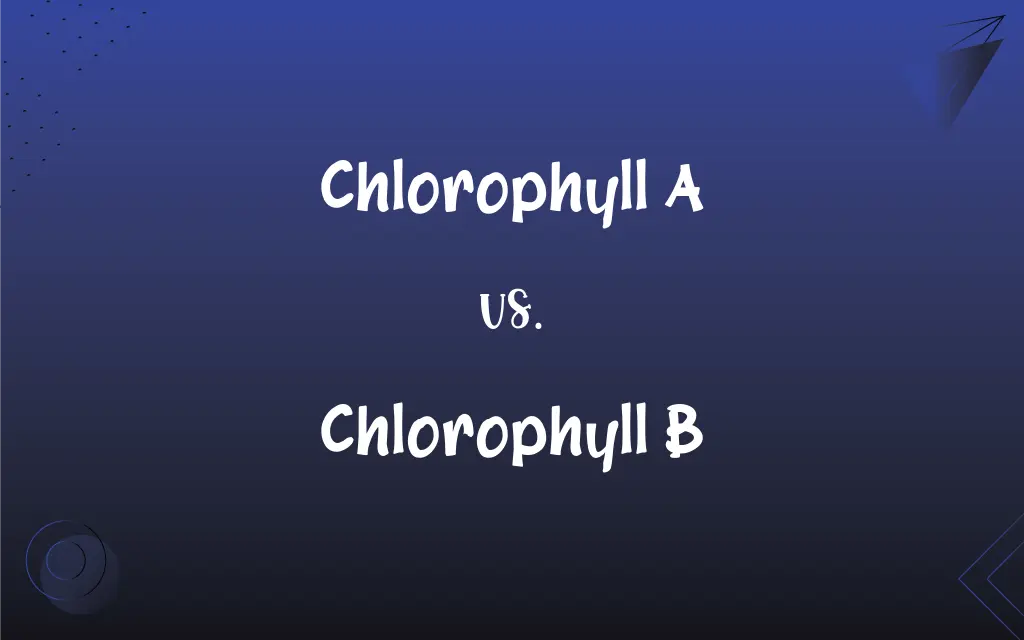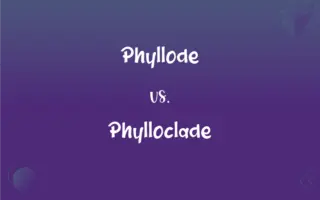Chlorophyll A vs. Chlorophyll B: What's the Difference?
Edited by Aimie Carlson || By Harlon Moss || Updated on October 18, 2023
Chlorophyll A is the primary photosynthetic pigment, while chlorophyll B is an accessory pigment assisting in capturing light. Both are essential for plants' energy absorption.

Key Differences
Chlorophyll A is the main pigment involved in photosynthesis. It captures light most efficiently in the blue and red parts of the electromagnetic spectrum. Chlorophyll B, on the other hand, acts as a supporting pigment, aiding chlorophyll a in capturing light energy.
Chlorophyll A stands out as the primary pigment responsible for converting light energy into chemical energy. It is the molecule that directly facilitates the photosynthesis process. Chlorophyll B, in contrast, mainly functions to broaden the spectrum of light that a plant can use by transferring the absorbed energy to chlorophyll a.
In terms of molecular structure, chlorophyll A has a CH3 group, making it different from chlorophyll B, which has a CHO group. These structural differences lead to variations in light absorption properties between them. Chlorophyll B, due to its structure, absorbs light in a region slightly shifted from that of chlorophyll a.
Both chlorophyll A and chlorophyll B are present in chloroplasts, the cell organelles where photosynthesis takes place. While chlorophyll A is always present in all photosynthesizing plants, chlorophyll B is not universal and may be absent in certain species.
Comparison Chart
Function
Primary photosynthetic pigment
Accessory pigment
ADVERTISEMENT
Absorption Peak
Blue and red light
Blue and orange light
Molecular Structure
Contains a CH3 group
Contains a CHO group
Presence in Plants
Universal in photosynthesizing plants
Varies among species
Role in Photosynthesis
Directly facilitates the process
Assists chlorophyll a in capturing light
Chlorophyll A and Chlorophyll B Definitions
Chlorophyll A
A molecule found in chloroplasts responsible for trapping light.
The richness of chlorophyll A in leaves gives them their vibrant green color.
ADVERTISEMENT
Chlorophyll B
A molecule differing from chlorophyll a in its molecular structure.
The CHO group in chlorophyll b distinguishes it from the CH3 group in chlorophyll a.
Chlorophyll A
A green pigment central to photosynthesis.
Chlorophyll A absorbs light efficiently in the blue and red spectrums.
Chlorophyll B
A pigment variant present in some, but not all, photosynthesizing species.
Some algae types lack chlorophyll b, relying solely on other pigments.
Chlorophyll A
A pigment that absorbs specific wavelengths of light to drive photosynthesis.
Chlorophyll A's unique absorption properties make it indispensable for plants.
Chlorophyll B
A molecule that transfers absorbed energy to chlorophyll a.
Chlorophyll b acts as a supportive agent, funneling energy to the primary pigment.
Chlorophyll A
The primary molecule that converts light energy into chemical energy in plants.
Without chlorophyll A, plants wouldn't be able to perform photosynthesis effectively.
Chlorophyll B
An accessory pigment in plants aiding in light absorption.
Chlorophyll b assists chlorophyll a by capturing a broader range of light wavelengths.
Chlorophyll A
The primary photosynthetic pigment in plants and algae.
Chlorophyll A plays a crucial role in transforming sunlight into energy.
Chlorophyll B
A green pigment that complements the absorption profile of chlorophyll a.
The presence of chlorophyll b helps plants utilize more sunlight for photosynthesis.
FAQs
How do chlorophyll a and b differ structurally?
Chlorophyll a has a CH3 group, whereas chlorophyll b has a CHO group.
Why is chlorophyll b considered an accessory pigment?
Chlorophyll b assists chlorophyll a in capturing a broader spectrum of light.
What is the main function of chlorophyll a?
Chlorophyll a is the primary photosynthetic pigment converting light to chemical energy.
Are chlorophyll a and b found in the same cellular location?
Yes, both are located in the chloroplasts of plant cells.
Which chlorophyll is universal in photosynthesizing plants?
Chlorophyll a is universal, while chlorophyll b can vary among species.
Do all plants contain both chlorophyll a and b?
No, while all photosynthesizing plants contain chlorophyll a, not all contain chlorophyll b.
How do chlorophyll a and b influence leaf color?
Both contribute to the green color, with variations depending on their relative concentrations.
Can plants survive without chlorophyll a?
No, chlorophyll a is crucial for photosynthesis and energy production.
How do chlorophyll a and b affect plant health?
Both are vital for photosynthesis, the process that provides energy for plant growth.
Can photosynthesis occur without chlorophyll b?
Yes, but chlorophyll b broadens the light absorption range, enhancing efficiency.
How do chlorophyll a and b work together in photosynthesis?
Chlorophyll b captures and funnels additional light energy to chlorophyll a.
What role does chlorophyll b play in algae?
Like in plants, it assists chlorophyll a in capturing a broader spectrum of light.
Can chlorophyll a function without chlorophyll b?
Yes, but the presence of chlorophyll b enhances light absorption efficiency.
Are there other types of chlorophyll besides a and b?
Yes, there are other types like chlorophyll c and d, but a and b are most common in plants.
Is chlorophyll a more important than chlorophyll b?
Both have their roles; chlorophyll a is primary in photosynthesis, while b assists a.
What colors do chlorophyll a and b absorb best?
Chlorophyll a absorbs blue and red, while chlorophyll b absorbs blue and orange.
How do the molecular structures of chlorophyll a and b influence their functions?
Their structures determine their light absorption properties, impacting photosynthetic efficiency.
How does chlorophyll b assist plants?
Chlorophyll b acts as an accessory pigment, expanding the range of light absorption.
How do chlorophyll a and b respond to light?
Chlorophyll a absorbs mainly blue and red light; chlorophyll b absorbs blue and orange light.
Why do some plants lack chlorophyll b?
Evolutionary adaptations and specific environmental needs can lead to its absence.
About Author
Written by
Harlon MossHarlon is a seasoned quality moderator and accomplished content writer for Difference Wiki. An alumnus of the prestigious University of California, he earned his degree in Computer Science. Leveraging his academic background, Harlon brings a meticulous and informed perspective to his work, ensuring content accuracy and excellence.
Edited by
Aimie CarlsonAimie Carlson, holding a master's degree in English literature, is a fervent English language enthusiast. She lends her writing talents to Difference Wiki, a prominent website that specializes in comparisons, offering readers insightful analyses that both captivate and inform.































































